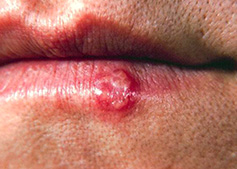PDF 84 KB
Herpes simplex virus type 1 (HSV1) causes cold sores on the face or lips - it is spread by skin or mucous membrane contact with infected saliva - fact sheet
Cold sores (also called fever blisters) are cause by herpes simplex virus. There are two types of herpes simplex virus, type 1 and type 2 (HSV1 and HSV2). Cold sores are usually caused by type 1 while type 2 is more often associated with genital herpes.
The virus is spread by skin or mucous membrane (the thin moist lining of many parts of the body such as the nose, mouth, throat and genitals) contact with infected saliva. People with a history of cold sores may shed the virus in their saliva even without a blister being present. Sometimes these viruses can cause infections of the eyes, hands or brain, and may cause severe illness in pregnant women or people whose immune systems are weakened.
 The most common symptoms of infection by herpes simplex virus type 1 (HSV1) are cold sores (see image). These are ulcers of the skin or mucous membranes (the thin moist lining of many parts of the body such as the nose, mouth, throat and genitals).
The most common symptoms of infection by herpes simplex virus type 1 (HSV1) are cold sores (see image). These are ulcers of the skin or mucous membranes (the thin moist lining of many parts of the body such as the nose, mouth, throat and genitals).
Although HSV1 infection can occur at any age, most people get their first infection in early childhood; frequently symptoms are mild or absent. After the first infection, the virus remains latent (resting) in nerve cells in the brain or spinal cord and is present for life. If the virus becomes active again it results in cold sores: painful clear blisters (see image) on a red base, usually on the face or lips. The blisters crust and heal within a few days. The virus can be triggered to become active again by physical or emotional stress, sunlight, a viral infection or hormonal changes. Appearance of the blisters is often preceded by tingling, itching and pain at the site.
Image courtesy Public Health Image Library (PHIL), Department of Health and Human Services, Centers for Disease Control and Prevention (CDC-USA) Dr Herrmann.
Herpes simplex virus infection can be diagnosed by scraping the base of the cold sore and examining cells under the microscope, by growing the virus, or by a PCR (polymerase chain reaction) test in a pathology laboratory. Blood tests are not usually helpful in diagnosis. About 80% of adults in Australia have antibodies to HSV1 and 25% have antibodies to HSV2.
(time between becoming infected and developing symptoms)
2 to 12 days.
(time during which an infected person can infect others)
Spread of infection is most likely when a moist blister is present. However, people with a history of cold sores may shed the virus in their saliva and are therefore capable of infecting others even without a blister being present.
Topical therapy (cream or ointment) is available through pharmacies. Oral (by mouth) antiviral therapy is available from pharmacies or by prescription from a doctor.
Image - Cold Sore (Herpes Simplex). Image courtesy of Public Health Image Library (PHIL), Department of Health and Human Services, Centers for Disease Control and Prevention (CDC-USA) Dr Herrmann